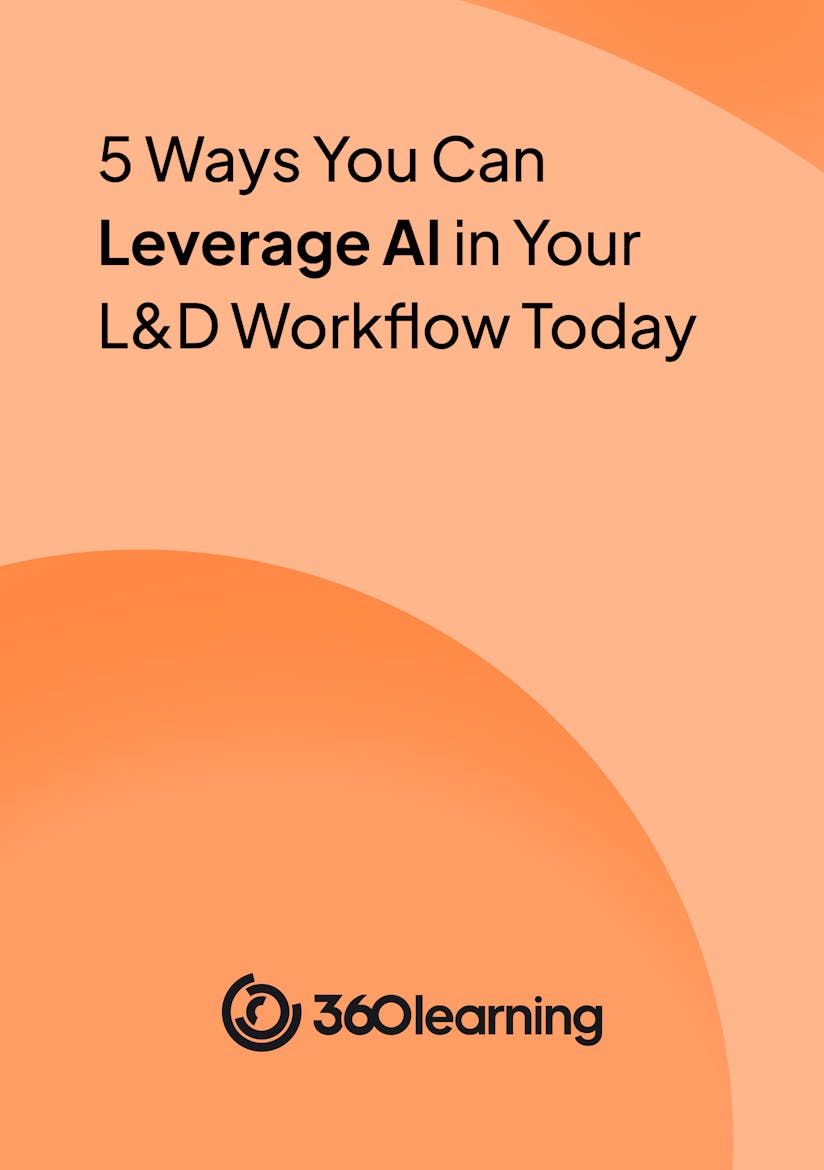
Generative artificial intelligence (AI) is predicted to disrupt a staggering 1.4 billion jobs worldwide over the next three years.
However, this is not an extinction event. Disruption just means things will change, and it’s essential to recognize that in the last 20 years, Google’s organization of the world’s information also had a tremendous impact–we’ve been here before and made it out.
In this webinar recap (you can access the full discussion here), we discuss what’s happening in the AI space at the moment, how it is being leveraged in learning and development (L&D), and what we should be doing as L&D leaders now so we don’t miss the bus.
What’s going on in AI right now?
Leveraging generative AI goes beyond using the tool as a more intelligent web searcher or content creator—it’s much more.
Critically, L&D needs to expand our thinking of generative AI beyond creating content because the more specific you can be and the more context you can build around the tool, the more you can shape its responses.
Think of AI like this: you have hired the smartest possible intern who doesn’t know much about your organization, but the more you train them, the more capable they become, and then the more you can let them off the lead.
The potential for L&D is impressive, considering that AI technology could fuel labor productivity and catapult global GDP by a remarkable 7% over time. For example, for workers across IT, marketing, sales, and service, 61% of workers currently use or plan to use generative AI, but most feel they’re not getting the training they need for it.
These challenges and concerns make it clear that knowing how to leverage AI properly is crucial to business success.

Have the robots really taken over?
By providing your contact info, you agree to receive communications from 360Learning. You can opt-out at any time. For details, refer to our Privacy Policy.
How is generative AI working in L&D?
The best way to leverage generative AI in your L&D practice is as your co-pilot, not your captain.
We’re not shying away from using AI as a profession, but we might not be going the right way about it. For example, many L&D leaders have tried AI in their day-to-day roles, but:
- 50% identified a lack of control over the output, leading to non-compliant or misaligned training content.
- 30% identified the content as “low-quality” or “generic.”
- 20% identified the manual process as lacking scalability and adaptability to meet learners’ needs effectively.
Many L&D professionals have never fully adopted the tool due to concerns with poor output resulting from a lack of personalization, context, and potential bias. Still, the tool can make an impact in the L&D space.
AI-powered tools can act as your super smart sidekick who doesn’t want any of the credit for your work. These tools will help us make learning experiences faster and draw on critical data we give it access to, including key organizational data.
AI-powered data for laser-focused L&D solutions
For effective L&D professionals, AI-powered tools won’t supersede but supercharge them.
AI will provide us with the business information and people data to recognize and validate problems. The data generated will help us uncover the cohorts responsible for the work and then create support and guidance using internal documentation in seconds. This means we can be laser-focused on assisting people to perform as expected.
Then, instead of getting subject-matter experts (SMEs) to create content from scratch, they can contextualize and add nuance to already created resources and experiences to ensure they are ready to help people do the right things.
We can better support internal mobility if we’re focused on helping to upskill and reskill in the context of our organizations.
What should AI shouldn’t be used for in L&D
You should still aim to create relevant, engaging learning experiences. Don’t let automation sidetrack you into thinking faster is always better.
Here’s what AI shouldn’t be used for:
- Creating more generic courses
- Simply getting courses out the door faster
- Minimizing the crucial role L&D leaders play in understanding learner needs and organizational goals
Generative AI’s most significant value to L&D is empowering organizational growth by providing the tools and data for faster and more accurate problem-solving. There needs to be a focus on human-centric learning, which means we need to democratize the learning process.
3 steps for AI-powered collaborative learning
What we really believe in at 360Learning is that traditional, top-down learning needs shaking up. That means shifting your practice to a collaborative learning approach.
Here are three key steps to help you get the most out of AI-powered collaborative learning in your L&D practice.
1. Transform your experts into super creators
AI-powered collaborative learning can help turn your organization’s internal experts into super creators of impactful and contextualized learning experiences.
Using AI, you can convert your domain expertise (what makes people successful in your organization) into resources that guide and support performance and will make an impact.
And instead of engaging your SMEs to be content creators alone, get them to be editors of the resources, which makes their job easier and quicker.
2. Deliver learning at the point of need
AI will help you deliver the right course to the right person at the right time.
First, by identifying learning needs based on the individual employee's profile, job, and skills, then servicing bite-sized learning seamlessly via tools in your working environment. Third, by answering your questions directly from trusted sources like a company knowledge base.
3. Enable data-driven decisions
Data and automation allow L&D to free up time from repetitive tasks and focus instead on business impact to stay ahead of the curve on what’s needed for your company.
And this comes down to augmentation and not just automation. By anticipating and identifying learning needs and skills gaps, you can increase learners’ engagement with action-driven analytics and automate time-consuming manual tasks.
The main takeaway
AI is only a threat to our jobs if we’re working without a sound learning and development strategy.
That’s why we need to:
- Focus on solving problems
- Use data end evidence to shape our training programs and prove our impact
- Promote upskilling and internal mobility with collaborative learning
- Focus on improving employee performance
- Embrace AI as your co-pilot, not your captain.
If you’re keen to dive deeper, you can watch the full webinar episode here: Navigating the AI Revolution.




